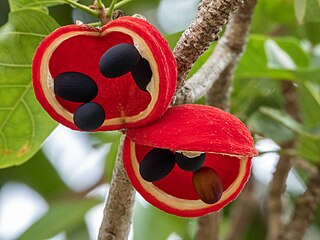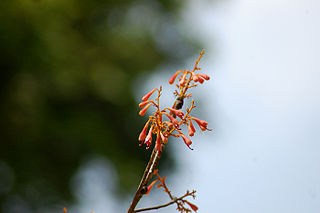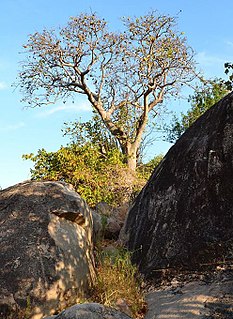
Sterculia is a genus of flowering plants in the mallow family, Malvaceae: subfamily Sterculioideae. Members of the genus are colloquially known as tropical chestnuts. The scientific name is taken from Sterculius of Roman mythology, who was the god of manure; this is in reference to the unpleasant aroma of the flowers of this genus. Sterculia may be monoecious or dioecious, and flowers unisexual or bisexual.

Nepenthes khasiana is an endangered tropical pitcher plant of the genus Nepenthes. It is the only Nepenthes species native to India. It is thought to attract prey by means of blue fluorescence.

Sterculia quadrifida, also known as the peanut tree, or red-fruited kurrajong is a small tree that grows in the rainforests, vine thickets, and gallery forests of New Guinea and northern Australia.

Sterculia colorata, the scarlet sterculia, is a medium-sized tree with spreading branches. It sheds leaves before the onset of flowering. After leaf-shedding, buds sprout and develop into flowers. The tree flowers from March to April.
Sterculia oblonga, the yellow sterculia, is a commercial timber tree in the family Malvaceae. It is native to the tropical rainforests of Cameroon, Ivory Coast, Equatorial Guinea, Gabon, Ghana, Liberia, Nigeria, and Sierra Leone. It is threatened by habitat loss.

The large hawk-cuckoo is a species of cuckoo in the family Cuculidae. It has a wide breeding distribution from temperate Asia along the Himalayas extending to East Asia. Many populations winter further south. They are known for their loud and repetitive calls which are similar to that of the common hawk-cuckoo but do not rise in crescendo. They are also somewhat larger and adults can be readily told apart from the smaller common hawk-cuckoo by the black patch on the chin. They are brood-parasites of babblers and laughing-thrushes.
Beauprea congesta is a species of plant in the family Proteaceae. It is endemic to New Caledonia.
Ilex khasiana is a species of plant in the family Aquifoliaceae. It is endemic to Meghalaya state in northeast India. Four very rare specimens grow on Shillong Peak, 10 km west of Shillong, Meghalaya.
Ixonanthes khasiana is a species of plant in the Ixonanthaceae family. It is endemic to northeast India. It is threatened by habitat loss.

Sterculia alexandri is a species of plant in the family Malvaceae. It is endemic to South Africa, occurring in the Eastern Cape, and only found in a few localities: the Winterhoek Mountains near Uitenhage, Van Staaden's Mountains near Port Elizabeth and the Kouga Dam at the start of the Baviaanskloof. It is threatened by habitat loss.
Sterculia cinerea is a species of plant in the family Malvaceae. It is found in Eritrea, Ethiopia, and Sudan.

Sterculia parviflora is a species of plant in the family Malvaceae. It is found in India, Indonesia, Malaysia, and Singapore.
Sterculia schliebenii is a species of plant in the family Malvaceae. It is found in Kenya, Mozambique, and Tanzania.

Sterculioideae is a subfamily of the family Malvaceae containing evergreen and deciduous trees and shrubs.

Sterculia foetida is a soft wooded tree that can grow up to 35 metres tall. It was described in 1753 by Carl Linnaeus. Common names for the plant are the bastard poon tree, java olive tree, hazel sterculia, wild almond tree, and skunk tree. This is the type species of the genus Sterculia and both names mean bad-smelling: the name Sterculia comes from Sterquilinus, the Roman god of fertilizer or manure.

Sterculia urens is a species of plant in the family Malvaceae. It is native to India and has been introduced into Burma. A small to medium-sized tree with a pale-coloured trunk, it is commonly known as the bhutyā in Marathi, kulu, Indian tragacanth, gum karaya, katira, sterculia gum or kateera gum. The specific name urens refers to the stinging hairs present on the flowers.

Sterculia africana is a deciduous tree, belonging to the genus Sterculia and the family Malvaceae. The species is sometimes called the "mopopaja tree". It is distributed throughout Northeast Africa to Arabia.
The Khasian leaf-nosed bat is a species of bat in the family Hipposideridae. It is endemic to Meghalaya, India. It is a cave-dwelling bat.










